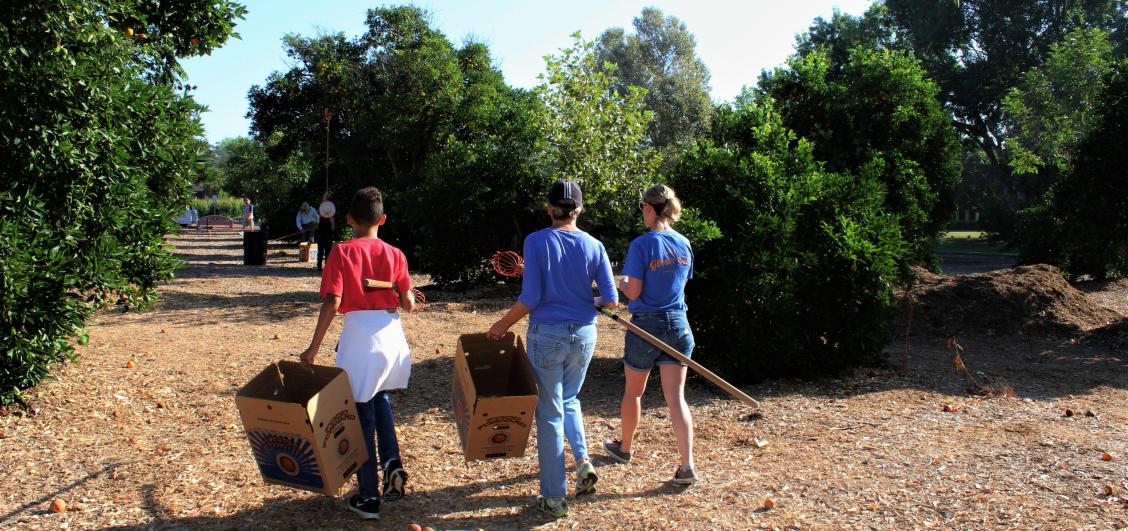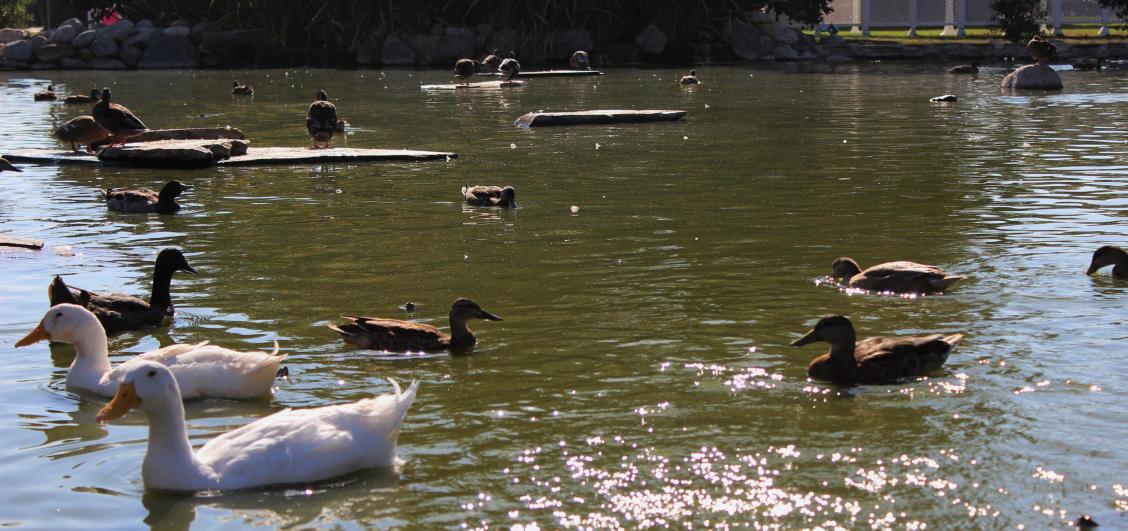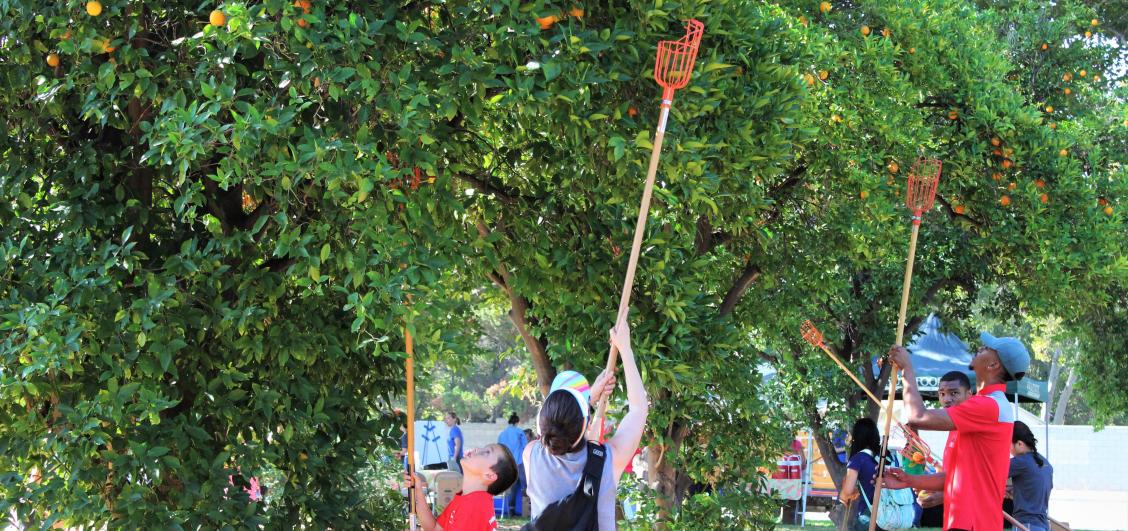Facilities@csun.edu
Office Hours:
M-F 8:00AM - 5:00PM
Phone: (818) 677-2561
Fax: (818) 677-6552
Valera Hall 325
CSUN Orange Grove and Pond
Orange Grove
With approximately five acres and more than 400 Valencia orange trees, the CSUN Orange Grove is a unique feature of the university’s campus landscape and urban forest. The Orange Grove has many facets in terms of its use, and existence, within the campus’ context. For example, the Orange Grove is actively used for research (studying bee populations and pond turtles), stellar and solar observatories are located in the grove, oranges are harvested and provided to local community groups who serve the needy, the area provides a scenic and tranquil place to visit, socialize and study, and to many the Orange Grove provides an remembrance of the agricultural past of Southern California.
History
While the university was established in 1958, the Orange Grove dates back only to the early 1940s. It is not known if the grove was ever used as a commercial growing operation since its existence prior to the university was very short lived. But the Orange Grove has remained an important part of the campus.
In 1959, the university’s first dormitory, Monterey Hall, was built to the east of the existing Orange Grove, with the original university master plan showing three future dormitories built to the west of Monterey Hall. Eventually, dormitories were built on North Campus, and Monterey Hall was converted to academic use.
In 1973 the University Club, later renamed The Orange Grove Bistro, was built to the west of Monterey Hall and the Orange Grove boundaries were established (see below). From 1975 to 2006 the grove saw very little activity.

Then in 2008, the university made significant improvements to the Orange Grove, providing easier and greater access, which in turn spurred more visitors, greater awareness and even further improvements.
Improvements
Starting with the 2005 Campus Master Plan update, the Orange Grove was seen as a campus asset. The Master Plan included future walkways, a pond, and observatory all shown as being added to the Orange Grove as a way to promote and use the grove as public space to enjoy and visit. With the construction of Chaparral Hall in 2007-08, the Pond and Stellar Observatory were added to the Orange Grove.
New decomposed granite walkways and lighting were also added throughout the Orange Grove, which allowed visitors a means to walk in and among the orange trees. Then in 2011 Haskell Walk was constructed, which linked Orange Grove Walk on the west (Later re-named Mike Curb Walk) to the Orange Grove Bistro and the G3 Parking Structure on the east. Additionally, new sidewalk lighting was installed to improve safety and aesthetics in the evenings.
In 2014, another observatory was added to the Orange Grove, the Solar Observatory, as well as a DC Solar Charging Station and picnic tables at the pond.
Most recently in 2016, CSUN’s Physical Plant Management renovated the pond’s pump and filtration systems to improve the overall ecosystem of the pond, which also included two new rock water falls and bio-filtration system.
Using the Campus as a Living Lab
The Orange Grove has many other institutional uses beyond a great place to visit, for example, the Biology Department tracks the turtle population, growth and birth rates. There is an active research project on honey bee hives, and the Marilyn Magaram Center on campus makes Matador Marmalade from the Oranges, just to name a few.
CSUN’s Institute for Sustainability has partnered with Food Forward for the past seven years to host orange picks and ensure that the fruit in CSUN's Orange Grove is utilized. In 2015, almost 17,000 lbs. of oranges were harvested and in April 2016, more than 400 volunteers spent four hours harvesting 12,785 lbs. of oranges. Oranges were sent to organizations such as Meet Every Need with Dignity (MEND), SOVA/Jewish Family Services of Los Angeles, Family Rescue Center and Seeds of Hope.
How does CSUN Maintain the Orange Grove?
Physical Plant Management Grounds Shop is responsible to actively manage the Orange Grove. Regular maintenance includes: tree trimming, annual tree replacements, irrigation, mulching, cleaning debris, emptying trash cans and maintaining the pond. Additionally, the Orange Grove is a significant component of CSUN’s Urban Forest Management Plan and the university’s Arbor Day Foundation Tree Campus USA designation in 2015 and 2016.
Maintenance Statistics:
- More than 100 trees have been replaced and replanted since 2008, 80 in 2006 and 75 in 1991.
- In 2007-08 the entire tree irrigation was upgraded to ensure proper and efficient watering through a water efficient drip system. In 2015-16 the irrigation control system was upgraded to ensure proper irrigation scheduling and for active monitoring.
- During 2016 more than 96,000 lbs. of mulch was placed in the Orange Grove to support water retention as well as reduce weeds. This mulch will be replaced as needed to keep the area aesthetically pleasing and functional.
CSUN Pond
Originally located just west of the Student Health Center, the CSUN Pond was relocated by Physical Plant Management (PPM) to the Orange Grove just before the start of construction of Chaparral Hall in 2007-08. Using the Orange Grove as a back drop, the new pond was carefully constructed to not damage any orange trees and included an extended waterfall, meandering stream bed, bridge, and an enlarged pond (about twice the size as the original location).
The new pond was an instant hit with the campus community and visitors. The pond is often cited as having the biggest impact on Orange Grove visitors.
The Pond was originally designed as a location to enjoy quiet tranquility and for birds to pass through on annual migrations. It housed a modest population of Koi fish, Mosquito fish (to control pests), a dozen or so California native turtles, and flowering lilies and other aquatic plants. Unfortunately, Red Eared Slider turtles purchased illegally in California were left at the pond by irresponsible pet owners. This invasive species quickly outperformed native species and decimated the vegetation.
Since then, CSUN has invested in the upgrade of pumping and filtration systems, increased water aeration, modified plant selections, and hired a full-time Grounds Worker who oversees the daily care of the Pond and surrounding landscape in collaboration with fellow grounds and skilled trades staff.
Pond Maintenance
In 2016, the pond and its infrastructure were completely renovated and upgraded. The pond was drained and the bottom cleaned, new circulation systems and mechanical and biological filtration systems were installed, new waterfalls and new shallow pools were constructed, new vegetation was planted and the Koi fish were restocked.
In addition to being a pleasant place to visit on campus, the CSUN Pond is a highly managed ecosystem. Students and faculty in CSUN’s Department of Biology have adopted the pond as a living laboratory. Several times each year, students receive hands-on training and experience at the pond, including assessing water quality, marking pond animals, monitoring animal population sizes and sex ratios and assessing reproductive trends. This information is included in analyses that assess animal population trends with a focus on sustainability.
Animals that inhabit the pond:
Reptiles
- Red-eared slider (Trachemys scripta elegans)
- Most of the turtles in the CSUN pond are sliders. Males are about one-half to one-third the size of females and have very long claws on their forelimbs. Sliders are omnivores, which means they eat just about anything, but their natural diet includes a variety of algae, aquatic plants, invertebrates (worms, snails, insects), fish and amphibians. During courtship in spring and summer, watch for males using their long claws to “tickle” the noses of females. During May and June, watch for females crossing through the Orange Grove, adjacent lawns, and across campus roads near the G3 parking structure in search of nesting sites to lay their eggs, which hatch about 70–90 days later. Widely introduced globally, this invasive species usually outcompetes native turtles in California and throughout the world.
Waterfowl
- Mallard (native and domesticated)
- Mallards (Anas platyrhynchos) are a mid-sized and heavy-bodied species of “dabbling duck” with broad, flat bills. Male mallards have a dark, iridescent-green head and neck, white collar and a bright yellow bill. Females and juveniles are mottled brown with a distinct eye stripe and orange-and-brown bills. Mallards are geographically widespread in the Northern and Southern Hemispheres and have been widely introduced across the globe as well. They inhabit a wide range of habitats from subtropical swamps to Arctic tundra, but primarily occupy shallow wetlands of both fresh and saltwater. Like other dabbling ducks, mallards are omnivores eating a variety of plants (roots, leaves, flowers and seeds) and invertebrates (worms, snails, insects and crustaceans). Mallards are social birds that aggregate in large flocks. During the breeding season (late spring), pairs form and will aggressively defend areas where they are nesting. Females lay large clutches of eggs (8–12), which hatch in about a month. Ducklings are precocial (able to eat and swim on their own). Mallards have become highly domesticated and the CSUN Pond typically has both wild and domesticated varieties in abundance.
- Domesticated and other Geese
- Many of the geese residing in the pond belong to one of several domesticated breeds of which there are several dozen globally. Most of these breeds can hybridize making breed identification a challenge. Geese have been domesticated for as long as 4,000 years in some countries. Generally, they have been selected to be larger (triple the size) and fatter than their native ancestors, as they were primarily bred for use as human food.
- Canada Geese (Branta canadensis), which are distinguished by their black head and neck and white chin and cheek patches, occasionally use our pond to fuel up on aquatic vegetation during stopovers on their migratory route.
Fish
- Koi
- Koi fish are domesticated and selectively bred descendants of the common carp (Cyprinus carpio), which has been a staple of Chinese aquaculture since the fifth century BCE. Koi varieties are distinguished by color, pattern, and the form of their scales, with more than 20 varieties recognized. Common colors are white, black, red, yellow, blue, and cream. They are omnivores that eat a variety of aquatic algae, plants and small invertebrates. They have been introduced to every continent except Antarctica, and some invasive populations have caused ecological damage to native ecosystems, particularly in Australia.
- Mosquitofish
- Mosquitofish (Gambusia affinis) are small freshwater fish (1.5–3 inches, with females about twice the size of males) that are native to the Mississippi River system. Mosquitofish are typically gray and have round-edged dorsal and tail fins and an upturned mouth. Females have a large abdomen with small black posterior spots and males have a tubular anal fin. Mosquitofish eat a variety of invertebrates, but are best known for their consumption of mosquito larvae. In fact, they hold the world record for being the most widespread freshwater fish species because they have been introduced globally as a biocontrol agent against mosquitos. Females give birth to live young and can produce up to six broods of embryos each summer.
CSUN Pond Website FAQs
Who takes care of the animals?
PPM staff checks the Pond daily to identify sick or injured animals in collaboration with the CSUN Biology Department. The Biology Department conducts regular population checks and tags/tracks turtles as part of an academic program. Turtles are tagged and tracked for size and growth. It is estimated that the Pond now houses over 300 invasive Red Eared Slider turtles – far above the population it was designed to hold. The regular population checks have also identified new full-grown turtles are being left at the pond regularly.
Smaller turtles are captured when possible and sent to local pond businesses for relocation to private ponds. CSUN Biology classes also regularly measure the Pond bacteria levels as part of the academic program to support student learning and monitor water safety.
Several volunteers frequent the pond to check on sick animals and communicate with PPM regarding concerns.
Can I drop my pet turtle or duck off at the Pond?
CSUN asks that people do NOT bring their unwanted pets to the Pond. The current population stresses the environment and additional crowding only endangers the health and wellness of existing wildlife.
Can I feed the animals?
It is best if animals forage for natural food sources than to provide foods that are not natural in the environment. Bread and other processed foods pollute the water and make animals sick – causing digestive problems and disease. Too much food encourages animals to breed and hinders natural duck migration patterns. Artificial food supplies also increase biological waste in the water which intensifies algae blooms.
While it is best to simply enjoy the animals through observation and allow them to care for themselves, if you feel you must feed them, please only bring zoo-grade pellets, cut seedless grapes, birdseed, peas, or corn.
There is a turtle in the street far away from the Pond.
Turtles wandering away from the Pond are typically looking for a place to nest and lay eggs. Usually, that occurs in the adjacent orange grove, however, sometimes they wander onto sidewalks and streets – even as far as Nordhoff. Unfortunately, the breeding patterns and behaviors of wildlife at CSUN are not something we can control.
That said CSUN PPM has placed natural obstacles to attempt to direct turtles away from the streets. Fences have proven to be ineffective as turtles are known to dig under and around enclosures. Additionally, fences are challenging as they can be unsightly and inhibit pedestrian foot traffic.
PPM also has a dedicated Grounds Worker who looks after the Pond and attempts to monitor wildlife in the area, however, sometimes wildlife movement occurs after the employee has left for the day.
Turtle crossing warning signs are a consideration but are challenging due to size and placement issues to be effective. Additionally, placing signs on Nordhoff or Zelzah is outside the CSUN jurisdiction as these are streets governed and regulated by the City of Los Angeles.
The water is green and soupy. Is that dangerous?
The green water is caused by algae blooms when temperatures rise. While they can be unsightly, algae blooms are common in ponds and are not indicative of unhealthy conditions for fish, turtles, or ducks. Pond goers occasionally falsely equate algal blooms with bacteria and a general lack of cleanliness because they can be unsightly. Algal blooms are caused by high levels of nitrogen and phosphorus that come from animal waste and overfeeding. PPM has added various types of aquatic vegetation and biofiltration methods that help remove those nutrients. PPM also conducts more frequent water exchanges and bottom vacuuming during the summer when algae blooms are more common. While both endeavors assist, they cannot completely alleviate algae blooms.
Bacterial levels in the pond are measured by CSUN Biology Department microbiologists and are safe for the animals as they measure at levels consistent with similar naturally occurring freshwater bodies.




